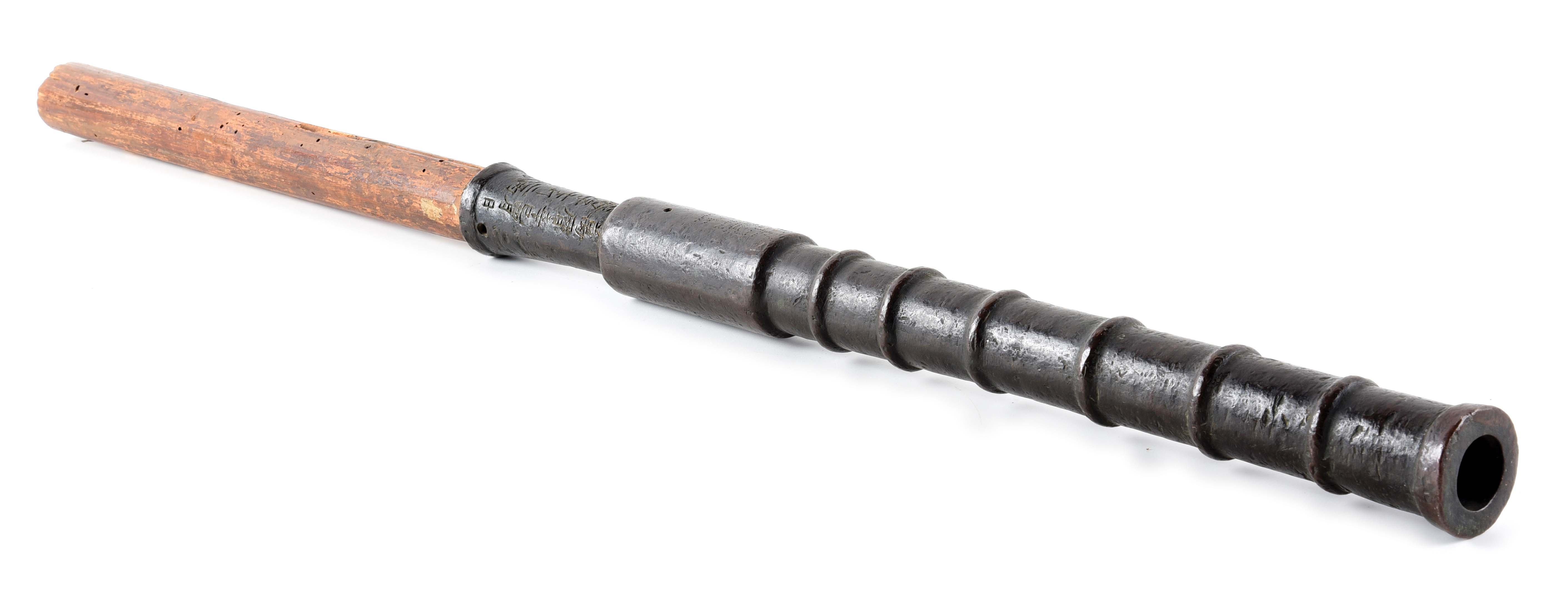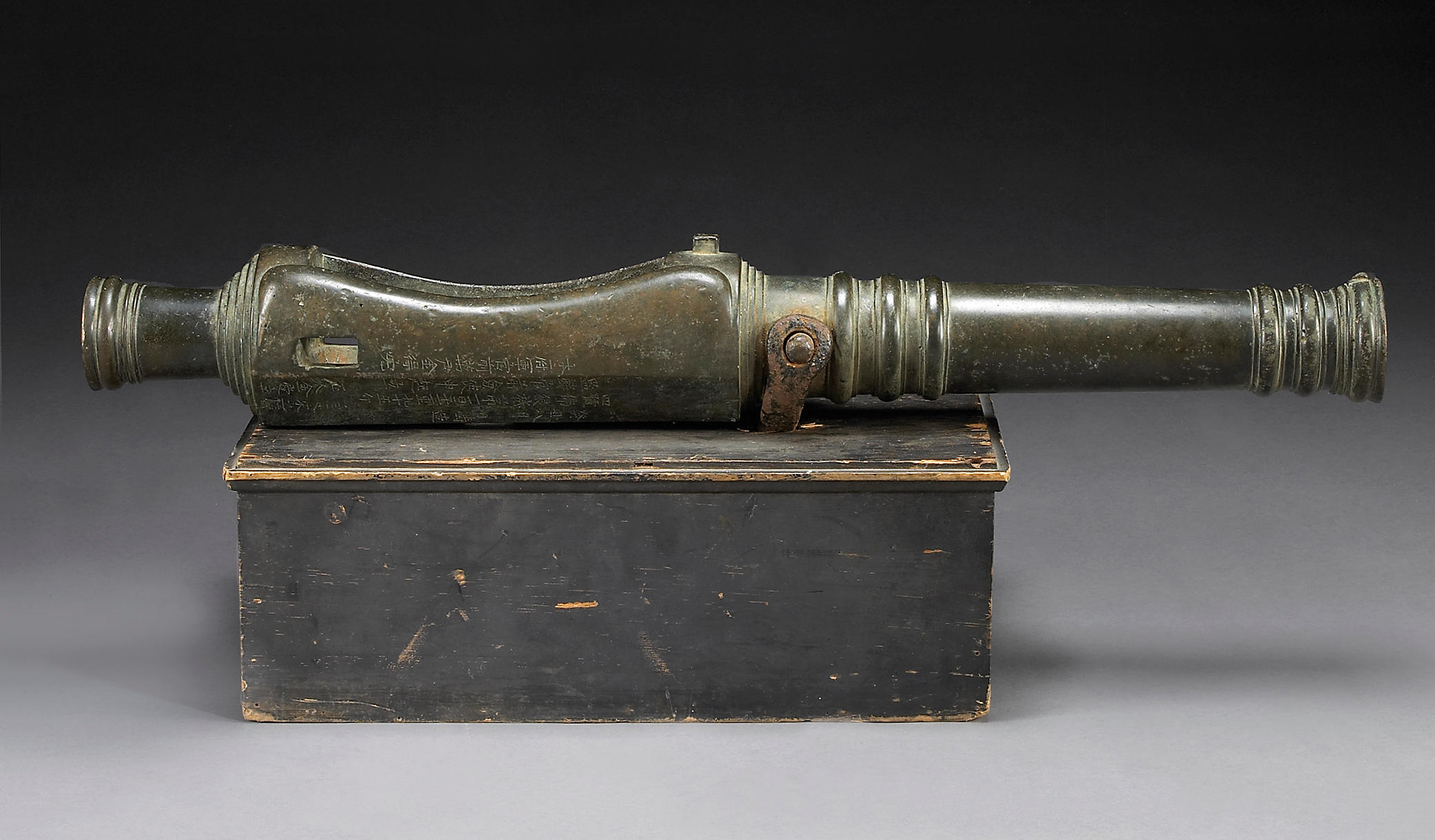Chinese Bronze Cannon and Caisson Dated 34th Year of the Reign of the Emperor Kangxi, 1695 The tapered cylindrical form incised at the breech with Chinese and Manchurian character inscription reading made on the 34th year of the reign of the Emperor Kangxi at Jingshan Nei Cannon titled General Zhisheng Specification powder capacity 1 jin 8 lians, iron cannon ball 3 jins, long range shot should be set at 45 degrees with slightly more powder added from top General Manufacture Executive Hai Qing - Imperial Guard 1st Class Manufacture Overseer Ba Fu Shou - Titled Manufacture Administrator Documentation Administrators Shuo Si Tai and Ge Er Tu Casting Masters Li Wende and Yuan Shi The caisson made up of Period wheels and metal straps restored based upon a contemporary model. Diameter of bore 3 inches, diameter of trunnions 3 inches, length 63 1/2 inches, length overall 9 feet 6 inches, diameter of wheel 39 inches. Provenance: Lieutenant Colonel Webb C. Hayes Western Reserve Historical Society, Cleveland, Ohio For similar examples see West Point Military Academy, West Point, New York Rutherford B. Hays Presidential Center, Freemont, Ohio During his reign (1661-1722) the educated and enlightened Emperor Kangxi traded and learned from Europeans while resisting their expansion. He invited Jesuits to court to teach mathematics, geography and science, as well as help in diplomatic and military affairs, all in an effort to modernize the Empire. The Emperor was known as a diligent and fair ruler, reigning for 61 years. The Jesuit priest Ferdinand Verbiest was born in 1623 in Belgium. His Chinese name was Nan Huairen. In 1659 he arrived in China, and by 1660 he was summoned to Beijing to assist Johann Adam Schall von Bell, the German missionary in charge of the Imperial Astronomy Board. At court, Verbiest taught rulers and high court officials. He composed a table of all solar and lunar eclipses for the next 2000 years, thus reworking the calendar, and was awarded head of the Mathmatical Board and Director of the Observatory by the Emperor. In 1673 half of China's territory was swept into "the Rebellion of the three Feudatories". The Emperor realized the repression of the rebellion would require a much improved artillery, with particular focus on mobile and nimble cannon. Verbiest was asked to take part in the casting of these light cannon. The Emperor sent orders to the board of war When Our Grand Army marches to suppress the rebels, it will need firearms very badly. We order Nan Huairen, the Director of the Imperial Board of Astronomy, to cast light but effective cannon, convenient for transportation, Kangxi shilu, p. 6b. quoted in the translation of Fu Lo-shu, A Documentary Chronical of Sino-Western Relations (1644-1820). Verbiest fulfilled his orders. A total of 905 cannon were cast during the Emperor Kangxi's reign, more than half were under Verbiest's supervision. Verbiest wrote a book on how to cast cannon for the Qing government titled the Shenwu tushuo, which has since been destroyed, but is described in another publication by Verbiest Xichao ding'an. Three types of cannon designed by Verbiest are mentioned in the Qinding da Qing huidian (Great Qing code approved by the Emperor), shenwei, wuchengyonggu and shengong. The cannon offered in the current sale is of the shengong variety. The overseers listed are Ba Fu Shou and Shuo Si Tai, the craftsmen Li Wende and Yuan Shi, in keeping with the inscription on the gun. The cannon are always cast in bronze, the mouth of the barrel being a little narrower than the rear part. The central part of the barrel is situated with two axles which support balance and adjust the slant while enlarging the cannon's power and movability, thus meeting the needs of the warfare of the Qing Dynasty. In a letter to The Honorable L. E. Holden, president Western Reserve Historical Society, dated 9 May 1901 written at Spiegel Grove, Fremont, Ohio Lieutenant Colonel Webb C. Hayes described the background of his
Cannon has even attractive green patina. Some pitting to bronze overall. Inscription is clear, not worn. Casson has original elements. The wheels are original and much of the iron strapping.
Chinese Bronze Cannon and Caisson Dated 34th Year of the Reign of the Emperor Kangxi, 1695 The tapered cylindrical form incised at the breech with Chinese and Manchurian character inscription reading made on the 34th year of the reign of the Emperor Kangxi at Jingshan Nei Cannon titled General Zhisheng Specification powder capacity 1 jin 8 lians, iron cannon ball 3 jins, long range shot should be set at 45 degrees with slightly more powder added from top General Manufacture Executive Hai Qing - Imperial Guard 1st Class Manufacture Overseer Ba Fu Shou - Titled Manufacture Administrator Documentation Administrators Shuo Si Tai and Ge Er Tu Casting Masters Li Wende and Yuan Shi The caisson made up of Period wheels and metal straps restored based upon a contemporary model. Diameter of bore 3 inches, diameter of trunnions 3 inches, length 63 1/2 inches, length overall 9 feet 6 inches, diameter of wheel 39 inches. Provenance: Lieutenant Colonel Webb C. Hayes Western Reserve Historical Society, Cleveland, Ohio For similar examples see West Point Military Academy, West Point, New York Rutherford B. Hays Presidential Center, Freemont, Ohio During his reign (1661-1722) the educated and enlightened Emperor Kangxi traded and learned from Europeans while resisting their expansion. He invited Jesuits to court to teach mathematics, geography and science, as well as help in diplomatic and military affairs, all in an effort to modernize the Empire. The Emperor was known as a diligent and fair ruler, reigning for 61 years. The Jesuit priest Ferdinand Verbiest was born in 1623 in Belgium. His Chinese name was Nan Huairen. In 1659 he arrived in China, and by 1660 he was summoned to Beijing to assist Johann Adam Schall von Bell, the German missionary in charge of the Imperial Astronomy Board. At court, Verbiest taught rulers and high court officials. He composed a table of all solar and lunar eclipses for the next 2000 years, thus reworking the calendar, and was awarded head of the Mathmatical Board and Director of the Observatory by the Emperor. In 1673 half of China's territory was swept into "the Rebellion of the three Feudatories". The Emperor realized the repression of the rebellion would require a much improved artillery, with particular focus on mobile and nimble cannon. Verbiest was asked to take part in the casting of these light cannon. The Emperor sent orders to the board of war When Our Grand Army marches to suppress the rebels, it will need firearms very badly. We order Nan Huairen, the Director of the Imperial Board of Astronomy, to cast light but effective cannon, convenient for transportation, Kangxi shilu, p. 6b. quoted in the translation of Fu Lo-shu, A Documentary Chronical of Sino-Western Relations (1644-1820). Verbiest fulfilled his orders. A total of 905 cannon were cast during the Emperor Kangxi's reign, more than half were under Verbiest's supervision. Verbiest wrote a book on how to cast cannon for the Qing government titled the Shenwu tushuo, which has since been destroyed, but is described in another publication by Verbiest Xichao ding'an. Three types of cannon designed by Verbiest are mentioned in the Qinding da Qing huidian (Great Qing code approved by the Emperor), shenwei, wuchengyonggu and shengong. The cannon offered in the current sale is of the shengong variety. The overseers listed are Ba Fu Shou and Shuo Si Tai, the craftsmen Li Wende and Yuan Shi, in keeping with the inscription on the gun. The cannon are always cast in bronze, the mouth of the barrel being a little narrower than the rear part. The central part of the barrel is situated with two axles which support balance and adjust the slant while enlarging the cannon's power and movability, thus meeting the needs of the warfare of the Qing Dynasty. In a letter to The Honorable L. E. Holden, president Western Reserve Historical Society, dated 9 May 1901 written at Spiegel Grove, Fremont, Ohio Lieutenant Colonel Webb C. Hayes described the background of his
Cannon has even attractive green patina. Some pitting to bronze overall. Inscription is clear, not worn. Casson has original elements. The wheels are original and much of the iron strapping.














/81621/Internet%20Image%201.jpg)
Testen Sie LotSearch und seine Premium-Features 7 Tage - ohne Kosten!
Lassen Sie sich automatisch über neue Objekte in kommenden Auktionen benachrichtigen.
Suchauftrag anlegen